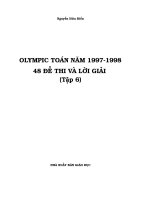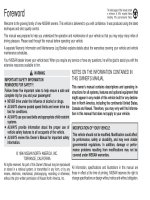C1183 91(reapproved 1997)
Bạn đang xem bản rút gọn của tài liệu. Xem và tải ngay bản đầy đủ của tài liệu tại đây (28.14 KB, 3 trang )
Designation: C 1183 – 91 (Reapproved 1997)
Standard Test Method for
Extrusion Rate of Elastomeric Sealants1
This standard is issued under the fixed designation C 1183; the number immediately following the designation indicates the year of
original adoption or, in the case of revision, the year of last revision. A number in parentheses indicates the year of last reapproval. A
superscript epsilon (e) indicates an editorial change since the last revision or reapproval.
5. Classification of Sealants
5.1 The sealant shall be classified by type as follows:
5.1.1 Type S—single-component sealant, and
5.1.2 Type M—multi-component sealant.
1. Scope
1.1 This test method covers two laboratory procedures for
determining the extrusion rate of elastomeric sealants for use in
building construction.
1.2 The values states in metric units are to be regarded as
the standard. The values in parentheses are for information
only.
1.3 This standard does not purport to address all of the
safety concerns, if any, associated with its use. It is the
responsibility of the user of this standard to establish appropriate safety and health practices and determine the applicability of regulatory limitations prior to use.
6. Apparatus
6.1 High Density Polyethylene Cartridge, with plunger and
cap, 177 mL (6 fluid oz) capacity, with the front end having an
inside diameter of 13.7 6 0.05 mm (0.540 6 0.002 in.).
6.2 Metal Nozzle, threaded to fit threaded end of polyethylene cartridge with the dimensions given in Fig. 1.
6.3 Air Supply, to provide 280 6 7 kPa (40 6 1 psi)
pressure with appropriate fittings and air lines to attach to an air
powered gun for convenience of use.
6.4 Caulking Gun, 177 mL (6 fluid oz) capacity, air powered.
6.5 Time Device, a clock or stop-watch graduated in seconds.
6.6 Small Container, can, cup, and so forth, as receiver for
extruded sealant.
6.7 Balance, accurate to 60.1 g (0.035 oz).
6.8 Pycnometer, or suitable apparatus to obtain a specific
gravity.
6.9 Thermometer.
6.10 Spatula.
2. Referenced Documents
2.1 ASTM Standards:
C 717 Terminology of Building Seals and Sealants2
D 1475 Test Method for Density of Liquid Coatings, Inks
and Related Products3
D 2452 Test Method for Extrudability of Oil- and ResinBase Caulking Compounds2
3. Terminology
3.1 Definitions—See Terminology C 717 for applicable
definitions of the following terms: caulking, compound, elastomeric and nonsag sealant, sealant.
4. Significance and Use
4.1 Sealants are supplied with various rheological properties
ranging from pourable liquids to nonsagging pastes. Singlecomponent sealants are supplied ready for use upon opening
the container. Multicomponent sealants are supplied as a base
component(s) and a curing agent separately packaged. After
mixing the two or more parts, the sealant is ready for
application. This test method is intended to provide a means to
measure the extrusion rate spanning the range of rheological
properties.
4.2 This test method measures the volume of sealant extruded in 1 min at a given pressure (kPa or psi).
7. Test Conditions
7.1 Unless otherwise specified by those authorizing the
tests, standard conditions for all tests are 23 6 2°C (73.4 6
3.6°F) and 50 6 5 % relative humidity.
8. Procedure
8.1 Type S (Single-Component)
8.1.1 Condition the unopened container of sealant for at
least 16 h at standard conditions.
8.1.2 Determine the specific gravity of the sealant as described in Test Method D 2452 or D 1475, or use another
scientifically correct technique.
8.1.3 Place a sufficient amount of sealant into the polyethylene cartridge to fill it completely with the plunger in place,
and level with the back of the cartridge.
1
This test method is under the jurisdiction of ASTM Committee C-24 on
Building Seals and Sealants and is the direct responsibility of Subcommittee C24.20
on General Test Methods.
Current edition approved April 15, 1991. Published June 1991.
2
Annual Book of ASTM Standards, Vol 04.07.
3
Annual Book of ASTM Standards, Vol 06.01.
NOTE 1—The cartridge filling is most easily accomplished by extruding
the sealant into the test cartridge through the nozzle end. Avoid any air
entrapment as this will significantly affect the accuracy of the results.
Copyright © ASTM International, 100 Barr Harbor Drive, PO Box C700, West Conshohocken, PA 19428-2959, United States.
1
C 1183 – 91 (1997)
NOTE 2—Curing times and conditions for multicomponent mixed
compounds may vary. Therefore, the length of time between mixing the
components and testing the extrusion rate may vary. Record the time from
mix completion to the start of the extrusion test.
9. Report
9.1 The report on the extrusion rate of Type S (singlecomponent), or Type M (multicomponent) sealants shall include the following information:
9.1.1 The trade name and other identification of the sealant,
9.1.2 The sealant type,
9.1.3 The specific gravity of the sealant,
9.1.4 The temperature of the sealant, if the sealant was
multicomponent,
9.1.5 The number of mL (rounded to the nearest 0.1)
extruded in 60 s, reported mL/min.
9.1.6 Any variations, specified or otherwise, from the above
described test method, including heating of sealant if so
required (Type S) or varying the length of the curing period or
temperature and humidity conditions (Type M),
9.1.7 For Type M sealants, describe the mixing system, the
time taken to mix and the time from mix completion to the start
of the extrusion test.
FIG. 1 Metal Nozzle Dimensions
8.1.4 Attach the nozzle to the cartridge, connect the air
supply and immediately extrude a small amount of material to
completely fill the nozzle. Wipe off the end of the nozzle with
a paper towel.
8.1.5 Extrude the sealant at 280 6 7 kPa (40 6 1 psi)
pressure into the preweighed container (nearest 0.1 g) for 60 s.
Make sure all of the material that has exited the end of the
nozzle is in the container.
8.1.6 Weigh the container to the nearest 0.1 g and subtract
the initial weight, to obtain the weight of the extruded sealant.
Convert the weight of the sealant to volume of sealant by
dividing the weight by the specific gravity. If all the material is
extruded in less than 60 s, note the length of time required and
calculate the volume of sealant that would have been extruded
in 60 s as follows:
10. Precision and Bias 4
10.1 Precision:
10.1.1 Round-robin testing of 5 Type S sealants by six
laboratories, using aluminum nozzles, indicates the precision
between laboratories is 60 % of the test result (two standard
deviations). Precision within a laboratory is estimated at 10 %
of the test result (two standard deviations). See Table 1.
Number of grams
60 seconds
Number of seconds 3 1 minute
TABLE 1 Precision Summary—Extrusion Rate of Elastomeric
Sealants
1
Number of milliliters
3 specific gravity 5
minutes
8.2 Type M (Multi-Component)
8.2.1 Condition the unopened containers for at least 16 h at
standard conditions.
8.2.2 Mix 100 g (3.53 oz) of the sealant with the proper
amount of curing agent and determine the specific gravity as
described in Test Method D 2452 or D 1475 or use another
scientifically correct technique.
8.2.3 Mix 400 g (14.12 oz) of the sealant with the proper
amount of curing agent, follow the mixing directions as
recommended by the manufacturer.
8.2.4 Place a sufficient amount of the mixed compound into
the polyethylene cartridge to fill it completely with the plunger
in place, and level with the back to the cartridge.
8.2.5 Within 30 min, attach the nozzle to the cartridge,
connect the air supply and immediately follow the procedures
described in 8.1. Measure the temperature of the sealant
immediately after weighing. Calculate the extrusion rate in
mL/min.
Material
Average
Value
Repeatability
Between
Lab
Percent
Within
Percent
Between
Precision
Between
A
B
D
C
E
27.201
44.589
49.989
73.071
83.089
0.884
2.036
0.994
2.718
5.942
7.260
13.802
14.496
21.283
20.679
3.249
4.566
1.989
3.721
7.152
26.691
30.953
28.999
29.126
24.887
7.314
13.951
14.530
21.456
21.516
4.135
28.131
One Standard Deviation
10.1.2 The precision of this test for Type M sealants is not
known and is subject to time of mixing, mixing technique and
equipment, temperature rise caused by mixing, and elapsed
time from mix completion to extrusion. See Table 1.
10.2 Bias—There is no statement on bias at this time.
11. Keywords
11.1 elastomeric sealant; extrusion rate
4
Supporting data are available from ASTM Headquarters, 1916 Race St.,
Philadelphia, PA 19103. Request RR:C24-1010 and 1016.
2
C 1183 – 91 (1997)
ASTM International takes no position respecting the validity of any patent rights asserted in connection with any item mentioned
in this standard. Users of this standard are expressly advised that determination of the validity of any such patent rights, and the risk
of infringement of such rights, are entirely their own responsibility.
This standard is subject to revision at any time by the responsible technical committee and must be reviewed every five years and
if not revised, either reapproved or withdrawn. Your comments are invited either for revision of this standard or for additional standards
and should be addressed to ASTM International Headquarters. Your comments will receive careful consideration at a meeting of the
responsible technical committee, which you may attend. If you feel that your comments have not received a fair hearing you should
make your views known to the ASTM Committee on Standards, at the address shown below.
This standard is copyrighted by ASTM International, 100 Barr Harbor Drive, PO Box C700, West Conshohocken, PA 19428-2959,
United States. Individual reprints (single or multiple copies) of this standard may be obtained by contacting ASTM at the above
address or at 610-832-9585 (phone), 610-832-9555 (fax), or (e-mail); or through the ASTM website
(www.astm.org).
3









